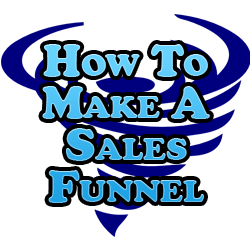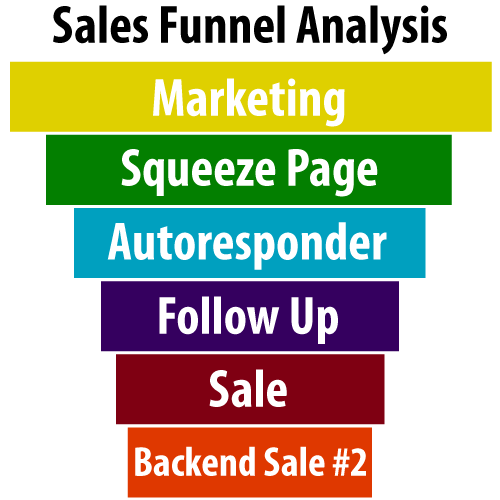A sales funnel is a powerful marketing tool, particularly for online marketers who typically don’t have a chance of having personal contact with their readers and customers as it’s all done online. The sales funnel’s purpose is to put a potential customer through a series of steps designed to lead them through a funnel so that if and when they reach the end, they’ll have little choice but to purchase the offer being marketed to them.
How To Make A Sales Funnel
There are a lot of different ways to make a sales funnel. One popular tactic when it comes to internet and affiliate marketing is to base your sales funnel around an autoresponder which is essentially a miniature sales funnel itself.
Sales Funnel Analysis
Let’s take a look at this sales funnel analysis chart and the various components of the funnel:
Marketing
Marketing is step one. Technically you’re marketing all throughout the funnel, but this is that initial contact where someone finds you online whether that’s through an article on an article directory, your Facebook or other social network page, or on your website itself. This first contact should establish the problem which the reader is having and then convince the reader to click through to your squeeze page or to some place where you can capture their email address. You can convince them by offering a solution to their problem which you established on this page, but the only way they’ll get that solution is to click through to your squeeze page.
Squeeze Page
The squeeze page is step number two. You direct your traffic from that initial contact page from step one to your squeeze page. The squeeze page is where you convey that the solution to the problem established in step 1 is in the autoresponder. See this post on how to set up a squeeze page for the best and easiest way to set up a squeeze page which will easily capture your subscriber’s email info and get them started on step three, the autoresponder.
Autoresponder
The autoresponder as I mentioned in opening is like a miniature sales funnel itself; it’s a set of prewritten emails which automatically are sent in linear order to every new subscriber on your list.
The purpose of setting up an autoresponder is threefold, to develop a relationship with your new subscriber so that the person becomes more acquainted with you and your brand, to get them in the habit of expecting emails/content from you in the future, and finally to sell. You can and should set up your autoresponder in the format of delivering a solution to your subscriber over the course of that autoresponder.
The autoresponder can be set up like a training course, offering tips and tricks for overcoming the problem while holding out on the complete and real solution – your product. This way, there is a healthy mix of free value and selling. This barrage of sales pitches for your product will typically work by the 7th email. If it doesn’t then you can go to the optional step four.
Follow Up
If your subscriber still hasn’t purchased your product after your lengthy 7-10 (recommended) autoresponder series, then they likely aren’t going to be persuaded by just another email about it. This is why I recommend that you send them a follow up where you offer your product to them at a special discounted price.
Sale
Hoorah! The sale has been made. Hopefully your product is of high quality so all of that selling will be worth it and you won’t see any refunds. If you’re tracking which email is linked to that purchase, you can place them in your segmented folder (see these email marketing tips on how to use email list segments) of existing customers as it’s valuable to be able to differentiate customers who have made a purchase from you versus subscribers who have not.
Backend
Your backend sales are where you make your serious money. This is a second, typically higher tiered product which you’ll offer to your customers who have purchased your first product because statistically someone who has previously made a purchase from you (existing customers) are much more likely to make a follow up purchase from you in the future.
Ideally you do have a relevant backend product which can piggyback on the success of the first product and offer your customer even greater value, and ideally you can start promoting that to your customer as soon as they purchase that first product (and still have their credit card out). I covered backend sales in full yesterday, so check that out.
There’s your sales funnel analysis; it can exist in a variety of formats, but this is one which is very effective at turning website or social network traffic into customers and pretty much on 100% automation at that.

